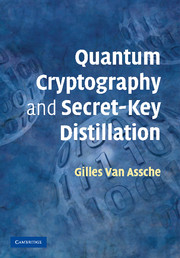Book contents
- Frontmatter
- Contents
- Foreword
- Preface
- Acknowledgments
- 1 Introduction
- 2 Classical cryptography
- 3 Information theory
- 4 Quantum information theory
- 5 Cryptosystems based on quantum key distribution
- 6 General results on secret-key distillation
- 7 Privacy amplification using hash functions
- 8 Reconciliation
- 9 Non-binary reconciliation
- 10 The BB84 protocol
- 11 Protocols with continuous variables
- 12 Security analysis of quantum key distribution
- Appendix symbols and abbreviations
- Bibliography
- Index
5 - Cryptosystems based on quantum key distribution
Published online by Cambridge University Press: 04 August 2010
- Frontmatter
- Contents
- Foreword
- Preface
- Acknowledgments
- 1 Introduction
- 2 Classical cryptography
- 3 Information theory
- 4 Quantum information theory
- 5 Cryptosystems based on quantum key distribution
- 6 General results on secret-key distillation
- 7 Privacy amplification using hash functions
- 8 Reconciliation
- 9 Non-binary reconciliation
- 10 The BB84 protocol
- 11 Protocols with continuous variables
- 12 Security analysis of quantum key distribution
- Appendix symbols and abbreviations
- Bibliography
- Index
Summary
In this section, I wish to put quantum key distribution (QKD) in the wider context of a cryptosystem. I shall discuss informally some aspects that are considered important. The questions I wish to answer here are: “What are the ingredients needed to make a QKD-based cryptosystem work? What services does it bring? What are its limitations?”
As I shall detail below, QKD may be used to provide the users with confidential communications. This can be achieved when we combine QKD and the one-time pad. For the quantum modulation, QKD needs a source of truly random numbers. Also, QKD requires a classical authenticated channel to work, so authentication plays an essential role. As a consequence, QKD must start with a secret key, making it a secret-key encryption scheme. I will also discuss what happens if classical cryptography is introduced in the system. Finally, I will describe the implementation of a simple cryptosystem on top of QKD.
A key distribution scheme
The first function of QKD is to distribute a secret key between two parties. The use of this key is outside the scope of this first section – the need for a secret key is omnipresent in cryptography.
As depicted in Fig. 5.1, QKD relies on a classical authenticated channel for sifting and secret-key distillation and on random bits for the modulation of quantum states. The key produced by QKD can be intended for encryption purposes – this will be discussed in Section 5.2 – but is also required by authentication. A part of the distributed key is used for authentication. When QKD is run for the first time, however, an initial secret key must be used instead.
- Type
- Chapter
- Information
- Quantum Cryptography and Secret-Key Distillation , pp. 63 - 84Publisher: Cambridge University PressPrint publication year: 2006
- 2
- Cited by



